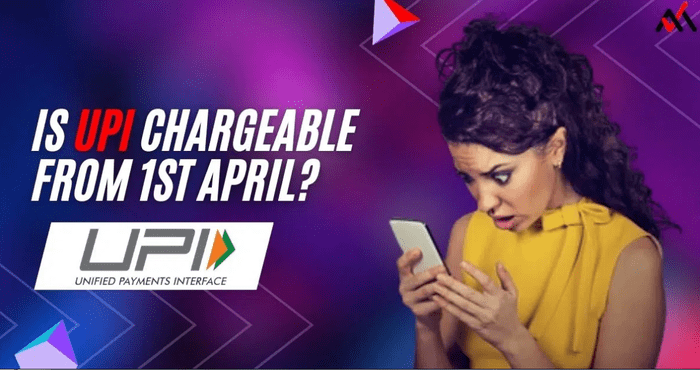
Now Pay Charges on UPI Transaction over Rs 2K from 1st April
Yes, you are reading the right heading, the National Payments Corporation of India (NPCI) has issued a circular in which it suggested “Prepaid Payment Instruments (PPI)” fees on merchant transactions on Unified Payments Interface (UPI).
The governing body of the UPI payment system added that the PPI fees would be levied on transactions above ₹2,000 on UPI. It will result in an interchange at 1.1% of the transaction value. And it is applicable to payments done through gift cards or wallets.
“It is further clarified that there are no charges for the bank account to bank account based UPI payments (i.e. normal UPI payments),” the NPCI added.
With this addition to UPI, the customers will have the choice of using any bank account, RuPay Credit card and prepaid wallets on UPI-enabled apps, it said.
Also Read: Now Use Credit Card to Make Payment through UPI: How to Link
The interchange fee is levied to cover the costs of accepting, processing, and authorising transactions. This is likely to make the transaction costlier. The new rule is applicable from 1 April 2023 onwards.

No charges will be paid by the customers, Paytm added. Taking to Twitter, the digital payment app wrote, “Please be informed that Paytm UPI is free, fast, secure, and seamless. No customer will pay any charges on making payments from UPI either from a bank account or PPI/Paytm Wallet”.
The issuer of prepaid instruments will also be required to pay 15 basis points of the fee to the remitter bank for loading a transaction value above ₹2,000, the circular said.
Notably, the fee will not be applicable to person-to-person transactions or person-to-merchant transactions between a bank and the prepaid wallet. And further NPCI will review the stated pricing on or before 30 September.
What are the Charges?
The interchange fee varies for the different categories of merchants. It starts from 0.5 per cent to 1.1 per cent and a cap is also applicable in certain categories.
For telecom, education, and utilities/post office, the interchange fee is 0.7 per cent while for supermarkets the fee is 0.9 per cent of the transaction value. About 1 per cent charges will be levied for insurance, government, mutual funds and railways, 0.5 per cent for fuel, and 0.7 per cent for agriculture.
“Interchange charges are only applicable for the PPI merchant transactions and there is no charge to customers,” NPCI said in a statement.
This levy was introduced to help cover the cost of interchange or interoperable between two wallets.
NPCI has permitted the PPI wallets to be part of an interoperable UPI ecosystem and levied 1.1 per cent charge on UPI transactions above ₹2,000 while using PPI.
Which transactions will not attract interchange fees, then?
NPCI said the interchange fee will not be applicable on P2P or peer-to-peer transactions and P2PM or peer-to-peer-merchant transactions between a bank account and a PPI wallet.
Essentially, this charge will only apply to digital wallet transactions made via merchant QR codes.
This means that all payments made using UPI such as Paytm, Phonepe, Google Pay to friends, family or to a merchant’s bank account will not be affected by this interchange fee.
So, who will pay these charges?
The fee of 1.1 per cent will not be charged on UPI payments, but only on payments of ₹2,000 or higher made from digital wallets to UPI IDs.
For instance, if a customer tries to make a PPI payment via UPI (Paytm/Google Pay) at a store or online, and the QR code is that of PhonePe, then PhonePe will receive the applicable interchange fee from the merchant.
The fee will be levied on the merchant side. Therefore, merchants may or may not choose to pass on the extra fee to consumers.
What is PPI?
Prepaid payment instruments include mobile/payment wallets (such as Paytm Wallet, Amazon Pay Wallet, PhonePe Wallet), smart cards, stripe cards, paper vouchers, etc. With the use of PPIs, a person can send and receive money without any physical exchange of cash or card.
“The guidelines make wallets more appealing to customers by opening up newer use cases of payments. It will eliminate the need for customers to carry multiple cards, thereby reducing fraud and theft due to the exposure of card numbers,” said Akash Sinha, Co-founder & CEO, of Cashfree Payments.
Are there any other UPI transaction charges?
At present, there are no charges levied on transactions done via UPI. The government had mandated a zero-charge framework for UPI transactions till now. This means that charges in UPI were nil for users and merchants alike.
The Volume of UPI Transactions
Share of the individual to merchants transactions above ₹2,000 is about 5 per cent of the total transactions last month.
In recent times, UPI has emerged as the preferred mode of digital payment by offering a free, fast, secure and seamless experience.
Also Read: How to Withdraw Cash from ATM without Card Using Your Phone
Traditionally, the most preferred method of UPI transactions is linking the bank account in any UPI-enabled app for making payments, which contributes over 99.9 per cent of total UPI transactions.
The volume of UPI transactions has increased manifold from 0.45 crore in January 2017 to 804 crore in January this year. The value of UPI transactions has increased from just ₹1,700 crore to ₹12.98 lakh crore during the same period.
Source: Livemint


